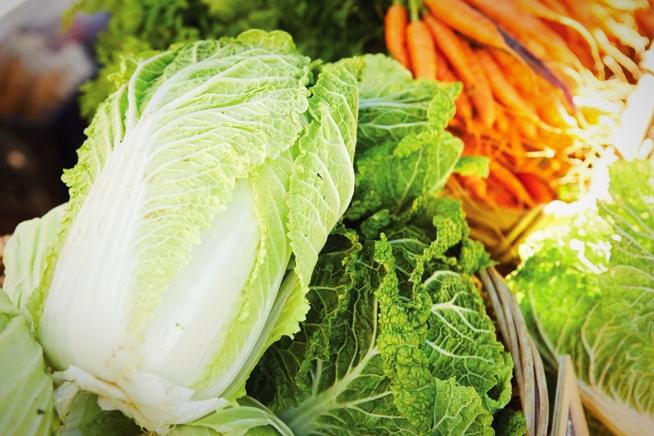Cabbage may seems like a boring winter vegetable, but it is anything but! Cabbage is an incredibly versatile vegetable: soft, buttery, and mellow when braised over low heat, crunchy and bright when raw in salads or coleslaws, and crisp but tender when quickly cooked. Lucky for us, this time of year you can easily find a variety of cabbage at the Saturday Morning Farmers’ Market!
When picking a good cabbage, look for one that is heavy for its size without excessive bruising. A cut end that is not brown, with crisp leaves, is a sign of freshness but a few blemishes on the outside leaves are fine; those can be removed and discarded before use. There’s a cabbage out there for every occasion, so keep reading to learn which cabbage is best for you!
Green and Red Cabbage
Green cabbage has a pale green color with wide fan-like leaves and a slightly rubbery texture. This cabbage is the all purpose cabbage, going well in salads, stir-fry, and slaws. It is somewhat peppery in flavor but mellows quite a bit (and turns slightly sweet!) when cooked.
Red cabbage is similar in appearance to green cabbage, but with a deep reddish-purple color that adds a pop to whatever dish it’s added to! Warning: It will turn blue when cooked, but can be counteracted by adding some sort of acid, such as lemon juice or vinegar. Both red and green cabbage are fairly long lasting.
cabbage is similar in appearance to green cabbage, but with a deep reddish-purple color that adds a pop to whatever dish it’s added to! Warning: It will turn blue when cooked, but can be counteracted by adding some sort of acid, such as lemon juice or vinegar. Both red and green cabbage are fairly long lasting.
Red cabbage is similar in appearance to green cabbage, but with a deep reddish-purple color that adds a pop to whatever dish it’s added to! Warning: It will turn blue when cooked, but can be counteracted by adding some sort of acid, such as lemon juice or vinegar. Both red and green cabbage are fairly long lasting.
Savoy and Napa Cabbage
Savoy
Quite possibly one of the prettiest cabbages (okay, they’re all pretty!), it is also known as lacy cabbage because of its curly, crinkly leaves that are less tightly packed than that of the green or red cabbage. This cabbage is very tender raw and its leaves make great wraps!
Napa
Also called “Chinese Cabbage”, Napa cabbage is more oblong than the savory or green cabbage, with thick white stems and frilly yellowish-green leaves. It looks a bit like romaine lettuce with a sweet, soft flavor. It works great as a dumpling filling and is tender enough to enjoy raw!
Stuffed Cabbage
Recipe courtesy of bonappetit.com
INGREDIENTS
Tomato Sauce
- 6 garlic cloves
- 1 large onion, coarsely chopped
- 3 tablespoons unsalted butter
- 2 bay leaves
- ½ teaspoon crushed red pepper flakes
- 1 28-ounce can crushed tomatoes
- 1 28-ounce can whole peeled tomatoes
- ¼ cup (packed) light brown sugar
- 2 tablespoons red wine vinegar
- Kosher salt, freshly ground pepper
Filling and Assembly
- 4 garlic cloves
- 1 large onion, coarsely chopped
- 2 celery stalks, cut into 1-inch pieces
- ¾ cup parsley leaves with tender stems
- 1 pound ground beef (20% fat)
- 1 large egg, beaten to blend
- ½ cup long-grain white rice
- 3 tablespoons dried currants or chopped golden raisins
- 2 teaspoons Worcestershire sauce
- 1 teaspoon Hungarian paprika
- 2 teaspoons Diamond Crystal or 1 teaspoon Morton kosher salt
- Freshly ground black pepper
- 1 large head of savoy cabbage, outer layer of leaves and core removed
- Sour cream or whole plain yogurt (for serving)
INSTRUCTIONS
- Tomato Sauce: Pulse garlic in a food processor until finely chopped. Add onion and pulse until onion is finely chopped.
- Melt butter in a large Dutch oven over medium heat until foamy. Add onion mixture and bay leaves and cook, stirring often, until onion is translucent and starting to brown, about 5 minutes. Add red pepper and cook until fragrant, about 30 seconds. Stir in crushed tomatoes, then add whole tomatoes, breaking up with your hands. Stir in brown sugar and vinegar; season generously with salt and black pepper. Reduce heat, bring to a simmer, and cook, uncovered and stirring occasionally, until sauce is thickened slightly and flavors have melded, 20–25 minutes. Remove bay leaves and let cool (you should have about 5 cups).
- Filling and Assembly: Pulse garlic in food processor until chopped. Add onion, celery, and parsley and pulse until finely chopped. Transfer to a large bowl and add beef, egg, rice, currants, Worcestershire, paprika, salt, and 1 cup tomato sauce; season generously with black pepper. Mix gently with clean hands until incorporated; set filling aside.
- Fill a large pot with 2″ water and place a steamer basket inside. Bring water to a boil, then place cabbage in basket. Cover and steam cabbage until outer layer of leaves is translucent and pliable, about 3 minutes. Using a pair of tongs, gently peel off softened leaves (being careful not to tear) and transfer to a large clean bowl. Cover pot and continue to steam cabbage until next layer of outermost leaves is translucent and pliable, about 3 minutes more. Remove leaves and transfer to bowl. Repeat until you have 16 leaves (you might eventually need to remove cabbage and cut farther into core so leaves easily detach at the base). Reserve remaining cabbage for another use.
- Using a paring knife, cut a narrow V-shape into the base of each leaf on either side of rib in order to remove thickest part of rib (this will make the leaves easier to roll).
- Preheat oven to 350°. Using a ⅓ measuring cup or 2½” (#12) scoop, portion out filling into centers of leaves. Shape filling into a log about 3″ long and 1″ wide. Starting at the base where you cut the V, fold end of leaf over filling, then fold in sides. Roll like a burrito into a tight cylinder. Repeat until you’ve rolled all 16.
- Ladle half of remaining tomato sauce into a 13×9″ pan, spreading into an even layer. Tightly pack cabbage rolls into 2 side-by-side rows (8 rolls in each). Top cabbage with remaining sauce; season with black pepper. Tightly cover with foil. Bake rolls until rice is tender and cabbage can be cut with a spoon, 1½–1¾ hours. Let cool slightly.
- Divide cabbage rolls among plates. Top with sour cream and serve.




